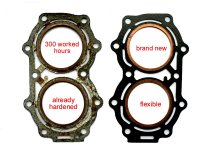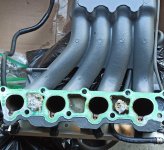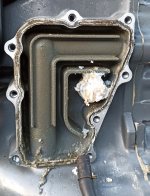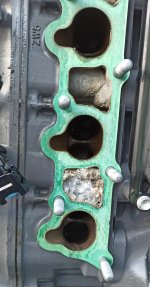Hi, I've been reading a lot from this forum in trying to diagnose my engine problem.
I own the engine for 2 years now. Serial number that is on the engine frame is bzbe 1400469. Looking up the info on the motor, it is a 2003 model so it should not have the problem with cracked head. This boat is mainly used in salt water once a month in Bodega Bay, CA. The last time I went out crabbing/fishing, there was no problem until we were going back in. The engine felt like it was in LIMP mode. No matter how much throttle I give it, the engine would surge. It would go up to 3k RPM maximum, if I go full throttle, the engine would rev up to 3k, drop down to 2k and repeat, sometime it would randomly pick up and go past 3k rpm, but only for short burst. In my mind, I'm thinking it must be a fuel related issue, as this happened before and I changed out the low & high pressure fuel filters, clean out the VST, go through all fuel related line and make sure no obstruction or air leak. That seem to helped with the surging.
Thinking that the motor is experiencing a fuel related issue, I pulled the VST again for cleaning and changed out all the fuel filters. The high pressure fuel pump insulator with screen was changed too. I purchased a fuel pressure gauge and tested the fuel pressure and it's sitting around 40 psi. Pulling the vacuum line from the pressure regulator while the engine is idling increases the fuel pressure, which I understand is NORMAL. So I now conclude that my surging problem is NOT fuel related (even though I did all this work, I know it's not fuel related because when inspecting all the fuel filters before they were changed, not much debris or water intrusion in gas).
Since I was doing all this maintenance and remembering that the last time I changed the oil was a long time ago (more than a year), I went ahead and changed the oil. I didn't even think about the oil because the oil pressure alarm/light never signal me to check the oil level. But I know now that I should check the oil level before every outing. Anyhow, there is water intrusion in the oil. The oil is milky gray, latte texture. The oil filling cap, have gray thicker sludge. This is definitely not good. The last time the oil was change, the oil was black.
I changed the oil and ran the engine on muff. The engine started normally and then stall. This is typical start up procedure for me. It normally start up and stall the first time, maybe second time, but after that, it will idle just fine. I normally help it warm up using the warm up lever to increase RPM. Even though the engine idle around 750rpm, it just doesn't feel right. I did the cylinder drop test by disconnecting the fuel injector wire one at a time to see any changes in the rpm. Disconnecting cylinder 1, 2 and 3 injector wire cause rpm to drop, however, with cylinder 4, no changes in rpm. This cause me to to believe, either I have no spark, clogged fuel injector or bad compression. I conduct compression test on all cylinder. Results are cylinder 1 175, cylinder 2 180, cylinder 3 190, cylinder 4 180 (at FULL throttle). So compression are okay, not great, but nothing that would keep the cylinder from missing. Checked spark on all cylinder and they are all good. Check injectors with stethoscope and they are good as well. I did notice however, when doing the compression test, there is definitely water intrusion into cylinder 4. ALso when removing the fuel rails to inspect the injectors, I do see a little water puddle.
Sorry for the long post, I just wanted to give all the information.
So in summary, I have water intrusion in cylinder 4 and water in my oil. Does this mean I should pull the head cylinder and hope it is a blown head gasket? The metal material head gasket is protruding in the port side of the engine. I'm attaching photo. Im also thinking there can be a crack somewhere?? What should I do? Should i remove the head cylinder to explore? OR what do you think my problem could be. I just don't understand with water in the oil, and water in the cylinder, why the engine can still run 4-5k rpm. IT's definitely sporadic though.
I own the engine for 2 years now. Serial number that is on the engine frame is bzbe 1400469. Looking up the info on the motor, it is a 2003 model so it should not have the problem with cracked head. This boat is mainly used in salt water once a month in Bodega Bay, CA. The last time I went out crabbing/fishing, there was no problem until we were going back in. The engine felt like it was in LIMP mode. No matter how much throttle I give it, the engine would surge. It would go up to 3k RPM maximum, if I go full throttle, the engine would rev up to 3k, drop down to 2k and repeat, sometime it would randomly pick up and go past 3k rpm, but only for short burst. In my mind, I'm thinking it must be a fuel related issue, as this happened before and I changed out the low & high pressure fuel filters, clean out the VST, go through all fuel related line and make sure no obstruction or air leak. That seem to helped with the surging.
Thinking that the motor is experiencing a fuel related issue, I pulled the VST again for cleaning and changed out all the fuel filters. The high pressure fuel pump insulator with screen was changed too. I purchased a fuel pressure gauge and tested the fuel pressure and it's sitting around 40 psi. Pulling the vacuum line from the pressure regulator while the engine is idling increases the fuel pressure, which I understand is NORMAL. So I now conclude that my surging problem is NOT fuel related (even though I did all this work, I know it's not fuel related because when inspecting all the fuel filters before they were changed, not much debris or water intrusion in gas).
Since I was doing all this maintenance and remembering that the last time I changed the oil was a long time ago (more than a year), I went ahead and changed the oil. I didn't even think about the oil because the oil pressure alarm/light never signal me to check the oil level. But I know now that I should check the oil level before every outing. Anyhow, there is water intrusion in the oil. The oil is milky gray, latte texture. The oil filling cap, have gray thicker sludge. This is definitely not good. The last time the oil was change, the oil was black.
I changed the oil and ran the engine on muff. The engine started normally and then stall. This is typical start up procedure for me. It normally start up and stall the first time, maybe second time, but after that, it will idle just fine. I normally help it warm up using the warm up lever to increase RPM. Even though the engine idle around 750rpm, it just doesn't feel right. I did the cylinder drop test by disconnecting the fuel injector wire one at a time to see any changes in the rpm. Disconnecting cylinder 1, 2 and 3 injector wire cause rpm to drop, however, with cylinder 4, no changes in rpm. This cause me to to believe, either I have no spark, clogged fuel injector or bad compression. I conduct compression test on all cylinder. Results are cylinder 1 175, cylinder 2 180, cylinder 3 190, cylinder 4 180 (at FULL throttle). So compression are okay, not great, but nothing that would keep the cylinder from missing. Checked spark on all cylinder and they are all good. Check injector
Sorry for the long post, I just wanted to give all the information.
So in summary, I have water intrusion in cylinder 4 and water in my oil. Does this mean I should pull the head cylinder and hope it is a blown head gasket? The metal material head gasket is protruding in the port side of the engine. I'm attaching photo. Im also thinking there can be a crack somewhere?? What should I do? Should i remove the head cylinder to explore? OR what do you think my problem could be. I just don't understand with water in the oil, and water in the cylinder, why the engine can still run 4-5k rpm. IT's definitely sporadic though.
























